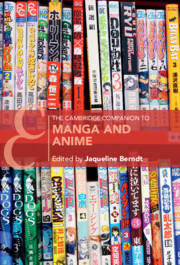Book contents
- The Cambridge Companion to Manga and Anime
- The Cambridge Companion to Manga and Anime
- Copyright page
- Contents
- Figures
- Contributors
- Acknowledgments
- Notes on Japanese Names, Terms, and Titles
- Chronology
- Introduction
- Part I Claimed Origins and Overlooked Traditions
- 1 Premodern Roots of Story-Manga?
- 2 Newspaper Comic Strips
- 3 Astro Boy and the “Weaponized” Children of Wartime Japan
- Part II Drawing and Movement
- Part III Sound
- Part IV Narrative
- Part V Characters
- Part VI Genres
- Part VII Forms of Production
- Part VIII Forms of Distribution
- Part IX Forms of Use
- Further Reading
- Index
- Cambridge Companions to Literature
2 - Newspaper Comic Strips
Laughs in Four Panels
from Part I - Claimed Origins and Overlooked Traditions
Published online by Cambridge University Press: 07 November 2024
- The Cambridge Companion to Manga and Anime
- The Cambridge Companion to Manga and Anime
- Copyright page
- Contents
- Figures
- Contributors
- Acknowledgments
- Notes on Japanese Names, Terms, and Titles
- Chronology
- Introduction
- Part I Claimed Origins and Overlooked Traditions
- 1 Premodern Roots of Story-Manga?
- 2 Newspaper Comic Strips
- 3 Astro Boy and the “Weaponized” Children of Wartime Japan
- Part II Drawing and Movement
- Part III Sound
- Part IV Narrative
- Part V Characters
- Part VI Genres
- Part VII Forms of Production
- Part VIII Forms of Distribution
- Part IX Forms of Use
- Further Reading
- Index
- Cambridge Companions to Literature
Summary
This chapter looks at a humor subgenre of manga defined by form, the four-panel (comic) strip known in Japanese as yonkoma manga. While this form has played a significant role in modern manga history, including a close interrelation with story-manga, it remains underrepresented in comics studies today. Yonkoma manga can be found in magazines and on internet platforms, but in this chapter, the focus leans toward newspapers where the strips initially developed and today still reach their widest audience. A brief historical overview of the development and current situation of four-panel strips is given before attention turns to their structure, usually described as ki-shō-ten-ketsu (introduction-development-turn of events-conclusion). How this conventional narrative structure is approached varies. This is demonstrated by introducing the creative processes of a few artists. To highlight this structure, an example strip is described. To move beyond mere explications of narrative pattern, however, this chapter ends with a simple application of linguistic humor theory to reveal in part how the humor is created, and to call for more engagement with humor theories in manga studies.
- Type
- Chapter
- Information
- The Cambridge Companion to Manga and Anime , pp. 31 - 43Publisher: Cambridge University PressPrint publication year: 2024

